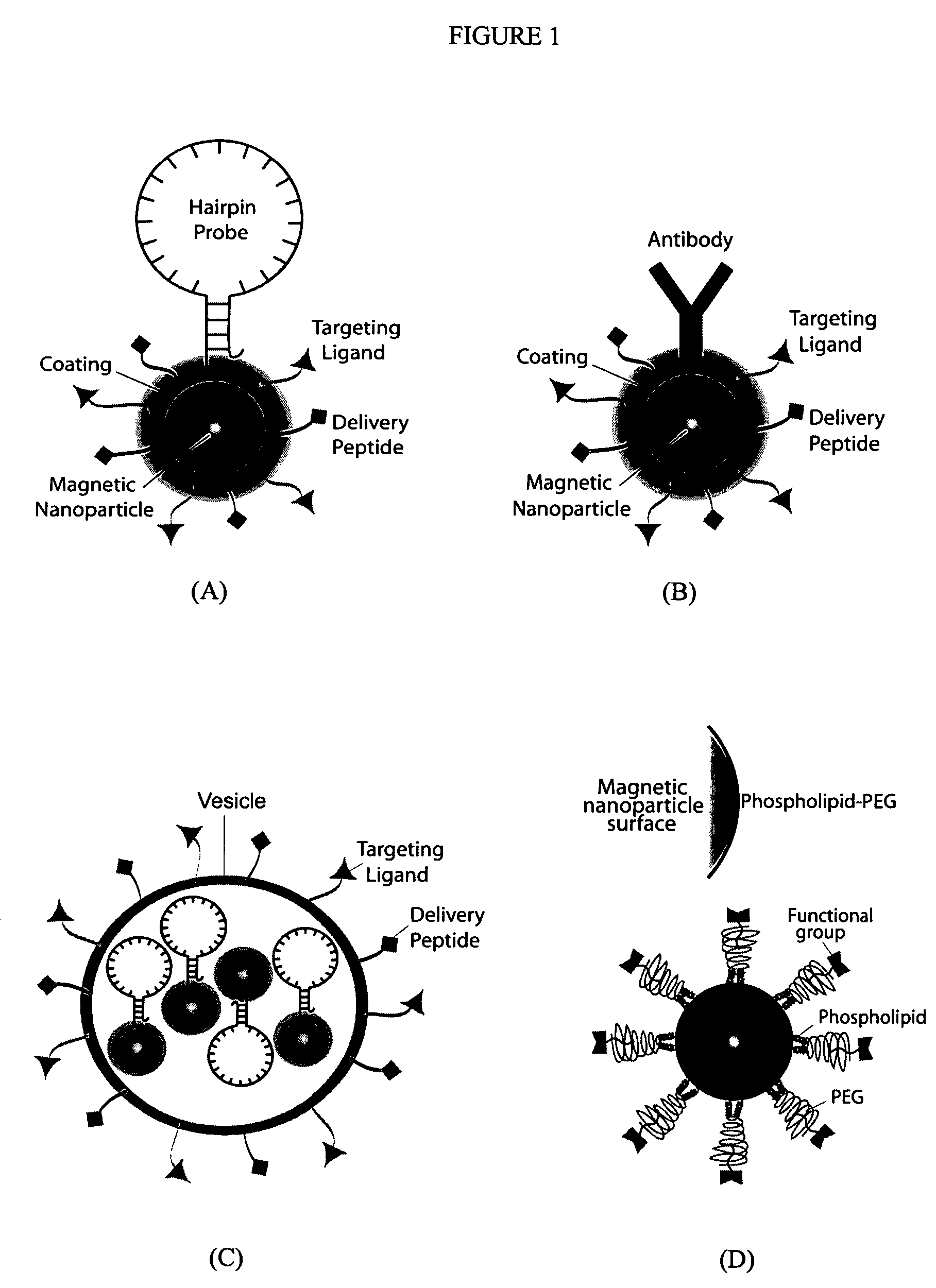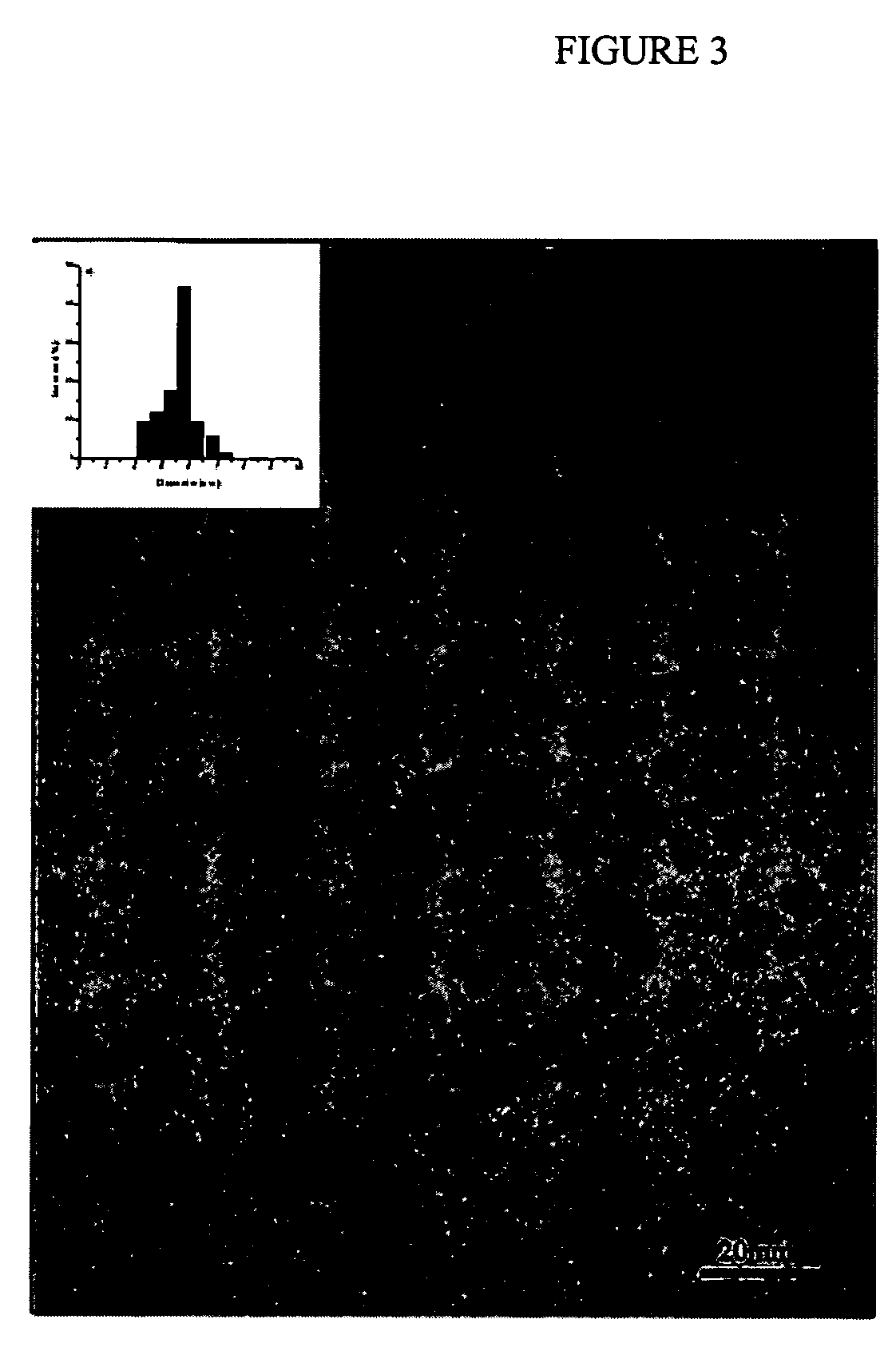Multifunctional magnetic nanoparticle probes for intracellular molecular imaging and monitoring
a magnetic nanoparticle and probe technology, applied in the field of multifunctional magnetic nanoparticle probes, can solve the problems of inability to quantify gene expression in living cells, lack of novel labeling reagents for in vivo protein expression and interaction studies, and no existing method that enables dynamics studies, etc., to achieve enhanced signal-to-noise ratio in molecular imaging, efficient internalization of magnetic nanoparticle probes, and high specificity and sensitivity
- Summary
- Abstract
- Description
- Claims
- Application Information
AI Technical Summary
Benefits of technology
Problems solved by technology
Method used
Image
Examples
example 1
[0166]Compared with micrometer sized magnetic particles and chelates of paramagnetic ions such as gadolinium diethylenetriaminopentaacetic acid (Gd-DTPA), magnetic nanoparticles are much more efficient as relaxation promoters, and their effect on the relaxivities of water is measurable even at nanomolar concentrations, as demonstrated theoretically and experimentally (Koenig et al., 1995; Bulte et al., 1992; Le Duc, 2001; Josephson et al., 2001; Perez et al., 2002). Specifically, the use of ferromagnetic and superparamagnetic nanoparticles as contrast agents can induce a more than 10 fold increase in proton relaxivities (Coroiu et al., 1999). Based on the enzyme-cleavable contrast agents reported by Meade and coworkers (Louie et al., 2000; Huber et al., 1998), magnetic relaxation by gadolinium atoms is a short-range effect. The presence of a carbohydrate cap (less than 1 nm thick) prevents water molecules from contacting the contrast agent Gd (HP-DO3A). In contrast, superparamagneti...
example 2
Encapsulation of the Magnetic Nanoparticles
[0170]A critical component for the success of this invention is to make monocrystalline iron oxide nanoparticles (MIONs) water-soluble and create a stable suspension of MIONs that are biocompatible and surface-functionalized. A standard approach in the field is to use the polysaccharide dextran. A distinct disadvantage to this approach is the large thickness of the coating (approximately 15 nm). In order to minimize steric hindrance in hybridization between two probes, it is crucial to minimize the size of the coating. Therefore, efforts in the present invention were focused on developing alternative coatings. Two such post-synthesis coating processes will be described in detail here.
[0171]The first coating uses the monolayer ligand 16-mercaptohexadecanoic acid (Liu and Xu 1995). The MIONs were reacted with the organic surfactant 16-mercaptohexadecanoic acid (MHA). MHA has a carboxylic head group at one end of the molecule that reacts with ...
example 3
Bioconjugation of Magnetic Nanoparticles to Create Multifunctional Probes for Imaging and Delivery
[0174]After encapsulation, the particles can be conjugated to peptides, proteins, fluorescent dye molecules, and hairpin oligonucleotide (ODN). Such conjugation is achieved by utilizing the functional group on the surface of the MIONs (in the specific cases described here, either reactive sulfhydryls or amines). These functional groups on the particle surface can be covalently conjugated to any of the above-described moieties by using standard cross-linking chemistry. Below will be described two specific examples of bioconjugation between MIONs and a) delivery peptide plus fluorescent dye and b) oligonucleotides. These examples use micelle-MIONs and MHA-MIONs, respectively; however, the coatings are versatile and either application is possible with both types of particles, with the micelle-MIONs being the preferred embodiment due to their superior solubility.
[0175]For optical imaging an...
PUM
| Property | Measurement | Unit |
|---|---|---|
| thick | aaaaa | aaaaa |
| core size | aaaaa | aaaaa |
| core size | aaaaa | aaaaa |
Abstract
Description
Claims
Application Information
 Login to View More
Login to View More - R&D
- Intellectual Property
- Life Sciences
- Materials
- Tech Scout
- Unparalleled Data Quality
- Higher Quality Content
- 60% Fewer Hallucinations
Browse by: Latest US Patents, China's latest patents, Technical Efficacy Thesaurus, Application Domain, Technology Topic, Popular Technical Reports.
© 2025 PatSnap. All rights reserved.Legal|Privacy policy|Modern Slavery Act Transparency Statement|Sitemap|About US| Contact US: help@patsnap.com



